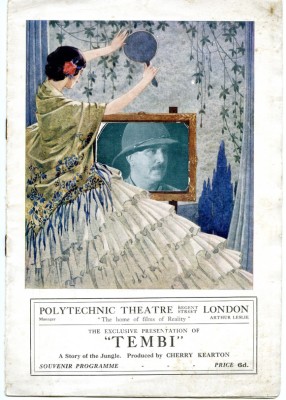The main hall at 307 Regent Street had a close connection with moving pictures, having hosted the first commercial film show in London on 21 February 1896.1 Originally constructed as part of the Royal Polytechnic Institution, the hall was remodelled several times over the following decades (in 1912 and 1927), hosting more film shows, including Alfred West’s popular ‘Our Navy’ and ‘Our Army’ presentations, and patriotic displays of war films during World War I.2
In the 1920s, the hall was converted to full-time cinema use (with some breaks to host stage plays), eventually becoming known as the Poly Cinema and later the Polytechnic Theatre. However, during this period, the cinema was still leased from the Regent Street Polytechnic, and, as the chairman of the Institute’s Finance and General Purposes Committee explained in 1927, the establishment had to approve all the films that were shown there.3 Exhibitors were expected to uphold the Polytechnic’s values, while also competing in the busy West End marketplace. Vivian Van Damm, who leased the hall from 1918 to 1920, described the problems he had enticing audiences to travel north of Oxford Circus without the attraction of first-release films. His response was to book The End of the Road, a ‘health propaganda film’ about the dangers of sexually transmitted diseases, which courted enough controversy to attract public interest.4
Later tenants tried different strategies. In 1922, a group of investors asked the filmmaker Adrian Brunel to programme a series of film revivals. He chose popular Hollywood titles including Daddy-Long-Legs, The Miracle Man, The Mark of Zorro and The Kid, as well as his own collaborations with A.A. Milne, Bookworms and The Bump. The idea, he later wrote, was to give ‘an opportunity seldom afforded the general public of witnessing films of intrinsic merit whether new or old’.5 In this way, the venue became an early example of the repertory cinema movement in London, which would soon take further shape in the Embassy Theatre, the Avenue Pavilion and the Palais de Luxe.
After new tenants took over the lease of the Polytechnic Theatre in 1923, a different policy was announced of showing films ‘only of nature and travel’.6 The cinema maintained its reputation as the ‘home of travel films’ for many years.7 Between 1923 and 1925, it showed long runs of early nature documentaries such as The Wonderland of Big Game and Climbing Mount Everest. These were often accompanied by commentary from explorers and exotic music (including musicians from Tibet), an approach that followed in the footsteps of earlier film shows at the venue before World War I, and that mirrored the format of other public lectures and presentations at the Polytechnic Institution.8 By the end of the 1920s, the cinema was calling itself ‘The Home of Films of Reality’.
The Polytechnic Theatre continued its policy of showing a combination of edifying travelogues, documentaries and feature films into the 1930s, and it remained in use as a cinema under a number of names until 1980.9 It is now part of the University of Westminster, and in 2015 it reopened after a major redevelopment project as the Regent Street Cinema.
Image: Programme for the film Tembi at the Polytechnic Theatre, ca.1929. Credit: Courtesy of the University of Westminster Archives.
Further reading:
- Adrian Brunel, Nice Work: The Story of Thirty Years in British Film Production (London: Robertson, 1949).
- Allen Eyles with Keith Skone, London’s West End Cinemas, third edition (Swindon: English Heritage, 2014).
- Joost Hunningher, ‘Première on Regent Street’, in Christopher Williams (ed.), Cinema: The Beginnings and the Future (London: University of Westminster Press, 1996), pp. 41-54.
- Elaine Penn (ed.), The Magic Screen: A History of Regent Street Cinema (London: University of Westminster, 2015).
- Vivian Van Damm, Tonight and Every Night (London: Paul, 1952).
- Joost Hunningher, ‘Première on Regent Street’, in Christopher Williams (ed.), Cinema: The Beginnings and the Future (London: University of Westminster Press, 1996), pp. 41-54. ↩
- Allen Eyles with Keith Skone, London’s West End Cinemas, third edition (Swindon: English Heritage, 2014), p. 45; Joost Hunningher with Ronald Gow, ‘Now Showing at 309 Regent Street – Ghosts on “Our Magic Screen”’: A Screen Play’, in Elaine Penn (ed.), The Magic Screen: A History of Regent Street Cinema (London: University of Westminster, 2015): p. 118. ↩
- The Polytechnic Finance & General Purposes Committee: Minute Book (20 November 1921-1 January 1929), meeting of 24 February 1927, p. 214, University of Westminster Archives, ACC2000/20. ↩
- Vivian Van Damm, Tonight and Every Night (London: Paul, 1952), pp. 40-3. ↩
- Adrian Brunel, Nice Work: The Story of Thirty Years in British Film Production (London: Robertson, 1949), p. 48. ↩
- ‘The Wonderland of Big Game’, The Times, 11 April 1923, p. 9. ↩
- Arthur Leslie, ‘The Home of Travel Films’, Documentary News Letter, July 1940, pp. 10-11. ↩
- Hunningher, ‘Now Showing at 309 Regent Street’, p. 124. ↩
- Eyles, London’s West End Cinemas, pp. 45-6. ↩



